Germany, France, Italy, Spain, Netherlands, Poland, Belgium, Sweden, Ireland, Austria, Norway, Denmark, Romania, Czech Republic, Finland, Portugal
By Wolf Richter for WOLF STREET.
This is our second annual wild ride across sales prices of existing homes of all types (“dwellings”) in the 16 largest economies that are either in the European Union (EU) or in the European Economic Area (EEA), based on data from Eurostat through Q1, released on Friday. The data goes back to 2005 for some countries, and less far for other countries.
Some countries have or had indeed the most splendid housing bubbles, and a few of those have deflated some. Other countries had the most splendid housing bubbles 15 or more years ago. A few didn’t have any housing bubbles at all. And one essentially went nowhere over the past 15 years. So a wild ride across the spectrum.
Biggest decliners from the peak and year of that peak:
- Finland: -14.6% from Q2 2022
- Italy: -14.3% from Q2 2011
- Germany: -11.3% from Q2 2022
- Sweden: -7.3% from Q2 2022
- Austria: -7.3% from Q3 2022
- France: -6.5% from Q3 2022
Triple-digit gainers from 2010 to their respective peak:
- Czech Republic: +146%
- Portugal: +139%
- Austria: +136%
- Norway: +111%
- Poland: 108%
- Germany: +106%
- Sweden: +103%
The home price indices for the biggest European markets:
The little tables show either three or four columns:
(1) % change from 2010 to the peak, whether the peak was in 2022 or in the current quarter. But in some countries, the peak was before 2010, such as in Italy and Spain, and those markets don’t have that column. (2) Quarter-over-quarter % change. (3) Year-over-year % change. And (4) % change in the current quarter from the peak.
Of the 16 markets, 7 are down from their peaks:
| Finland, Prices of Existing Homes | |||
| 2010 to Peak | QoQ | YoY | From peak |
| 16.5% | -1.6% | -2.3% | -14.6% |
The index fell back to where it had first been in 2010. This is an example of a housing market that really hasn’t gone anywhere in 15 years.
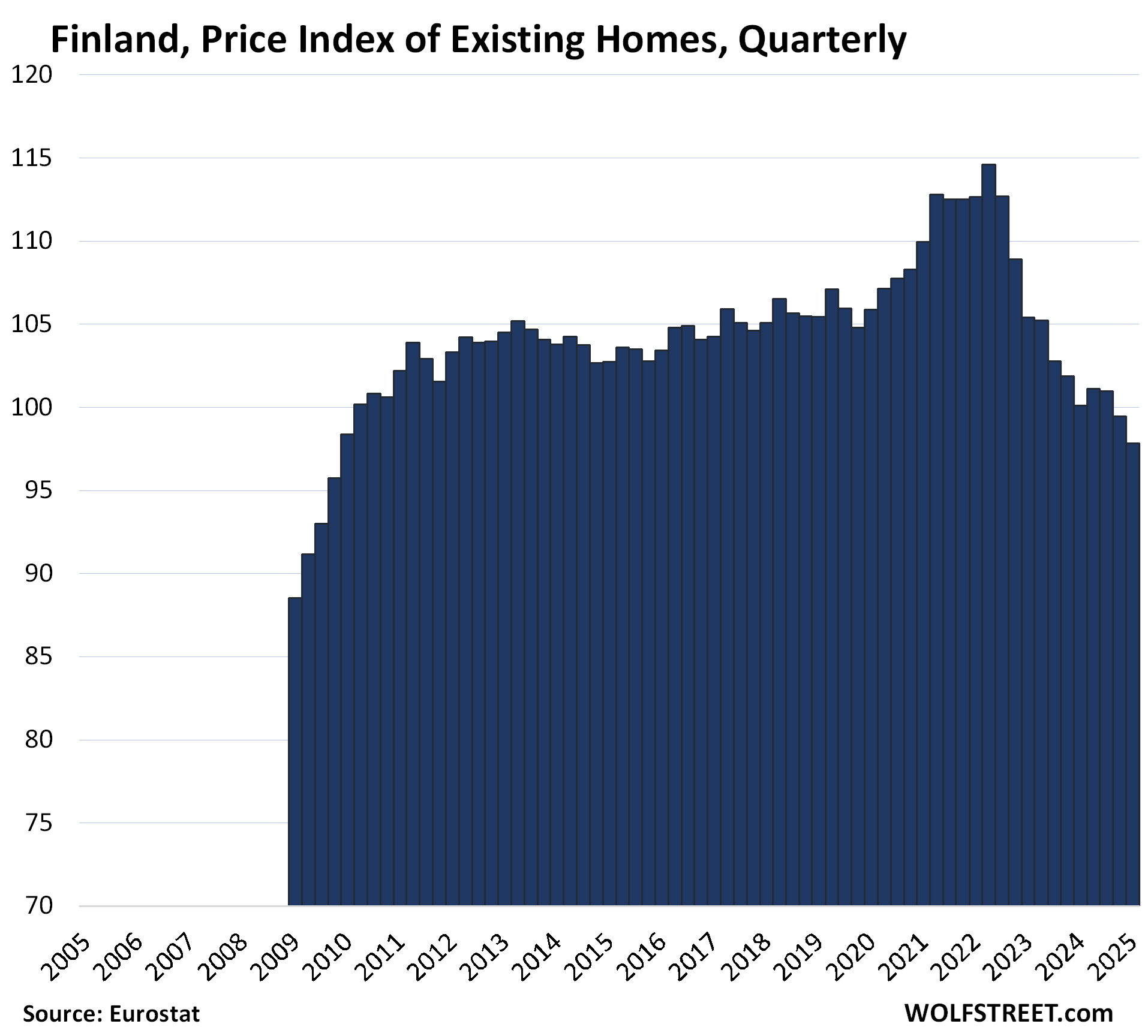
| Italy, Prices of Existing Homes | ||
| QoQ | YoY | From peak |
| 1.63% | 4.9% | -14.3% |
The recovery started during the pandemic.
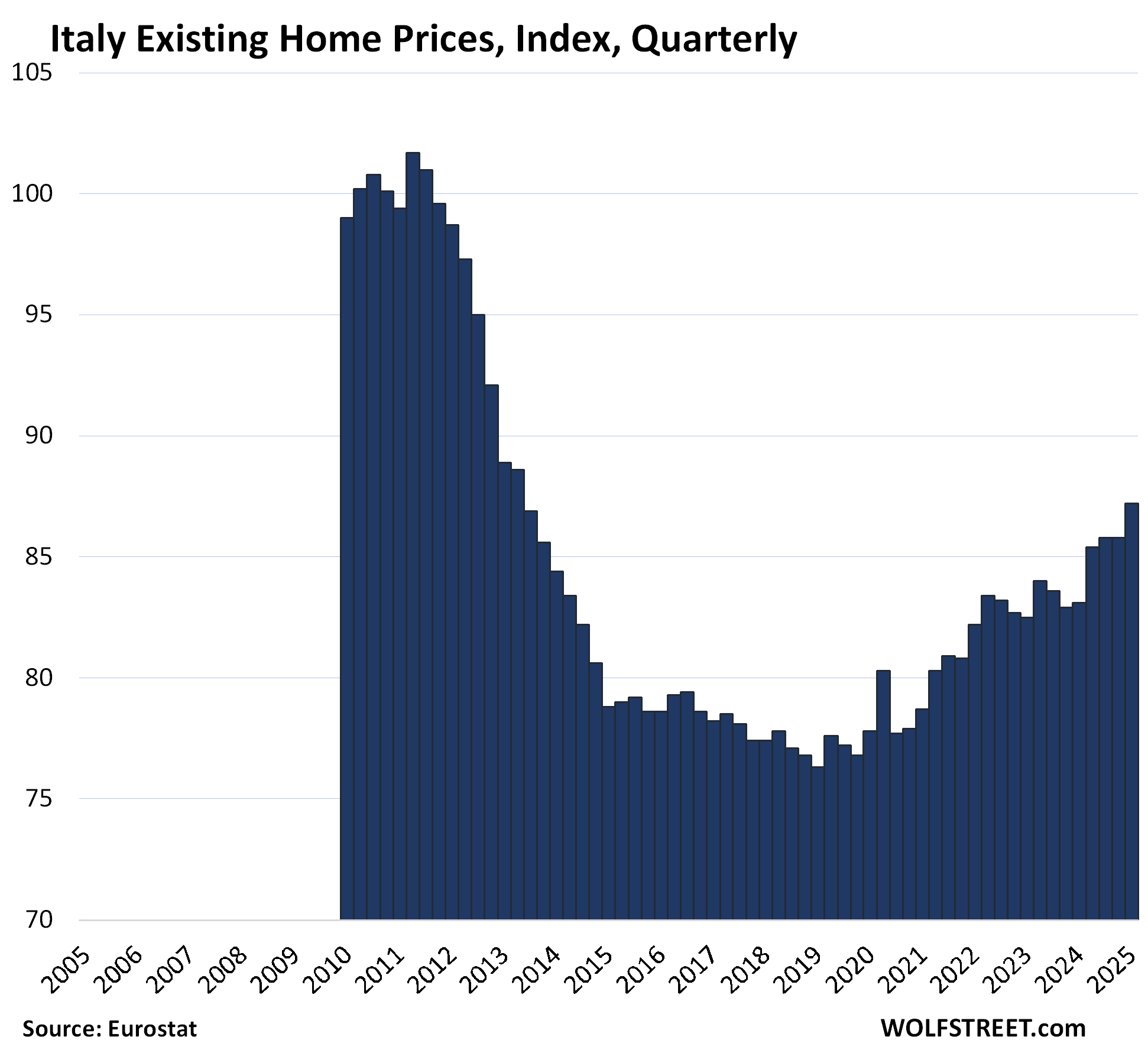
| Germany, Prices of Existing Homes | |||
| 2010 to Peak | QoQ | YoY | From peak |
| 105.7% | 1.3% | 3.6% | -11.3% |
The index is where it had been in 2021.
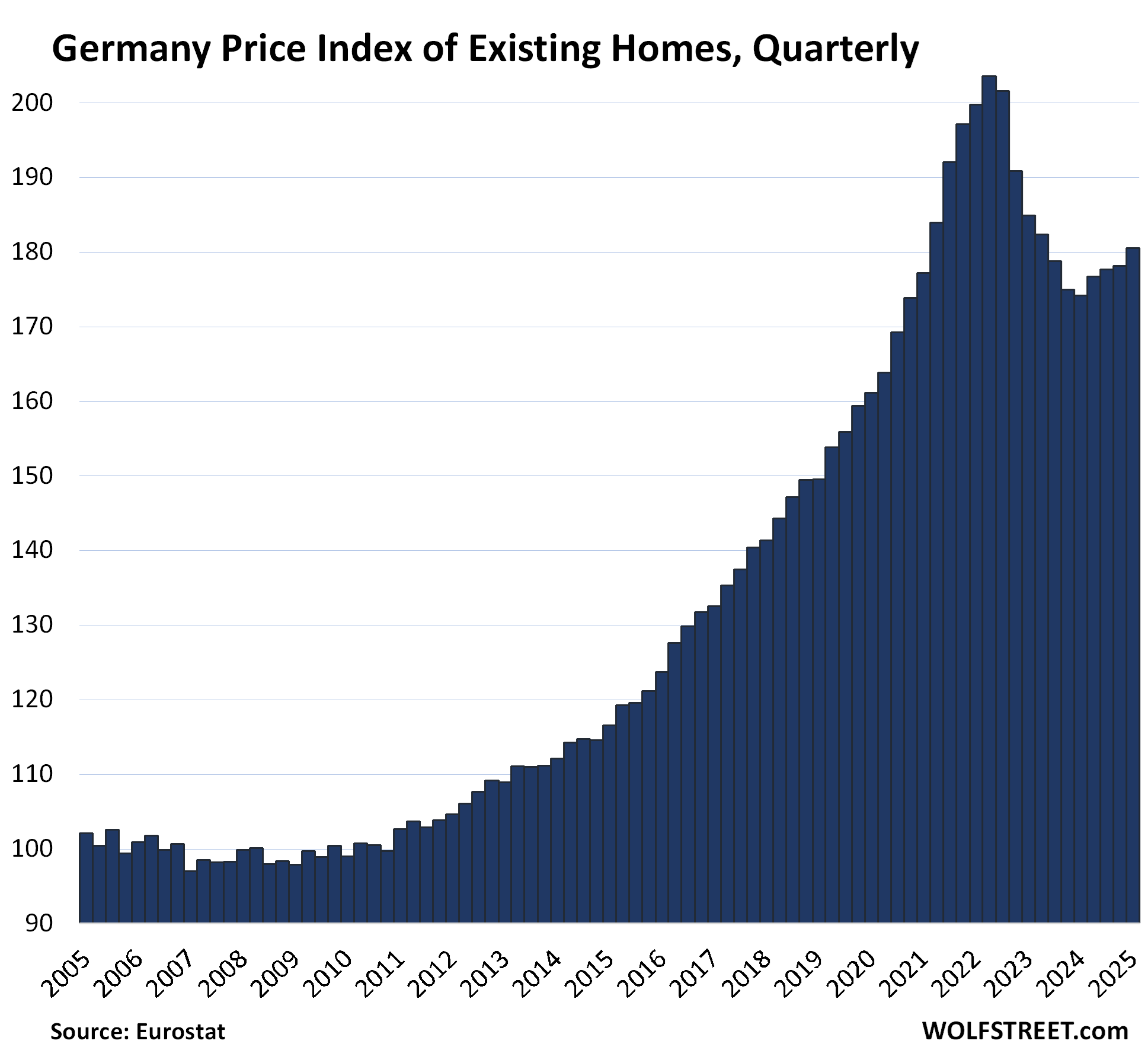
| Sweden, Prices of Existing Homes | |||
| 2010 to Peak | QoQ | YoY | From peak |
| 103.2% | 0.3% | 3.3% | -7.3% |
Also back to 2021.
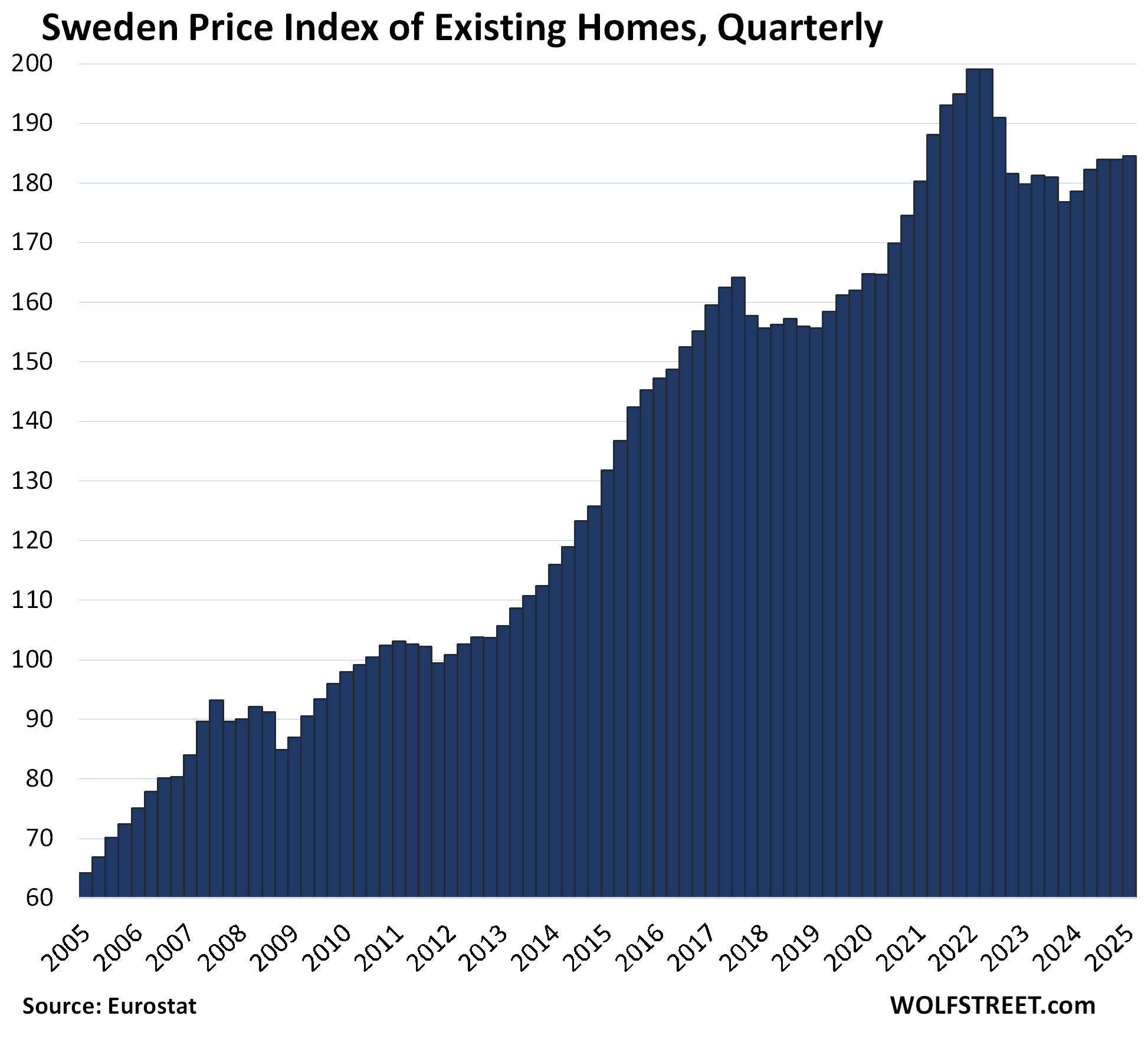
| Austria, Prices of Existing Homes | |||
| 2010 to Peak | QoQ | YoY | From peak |
| 136.2% | 1.1% | 3.3% | -7.3% |
The index is also back where it had been in 2021.
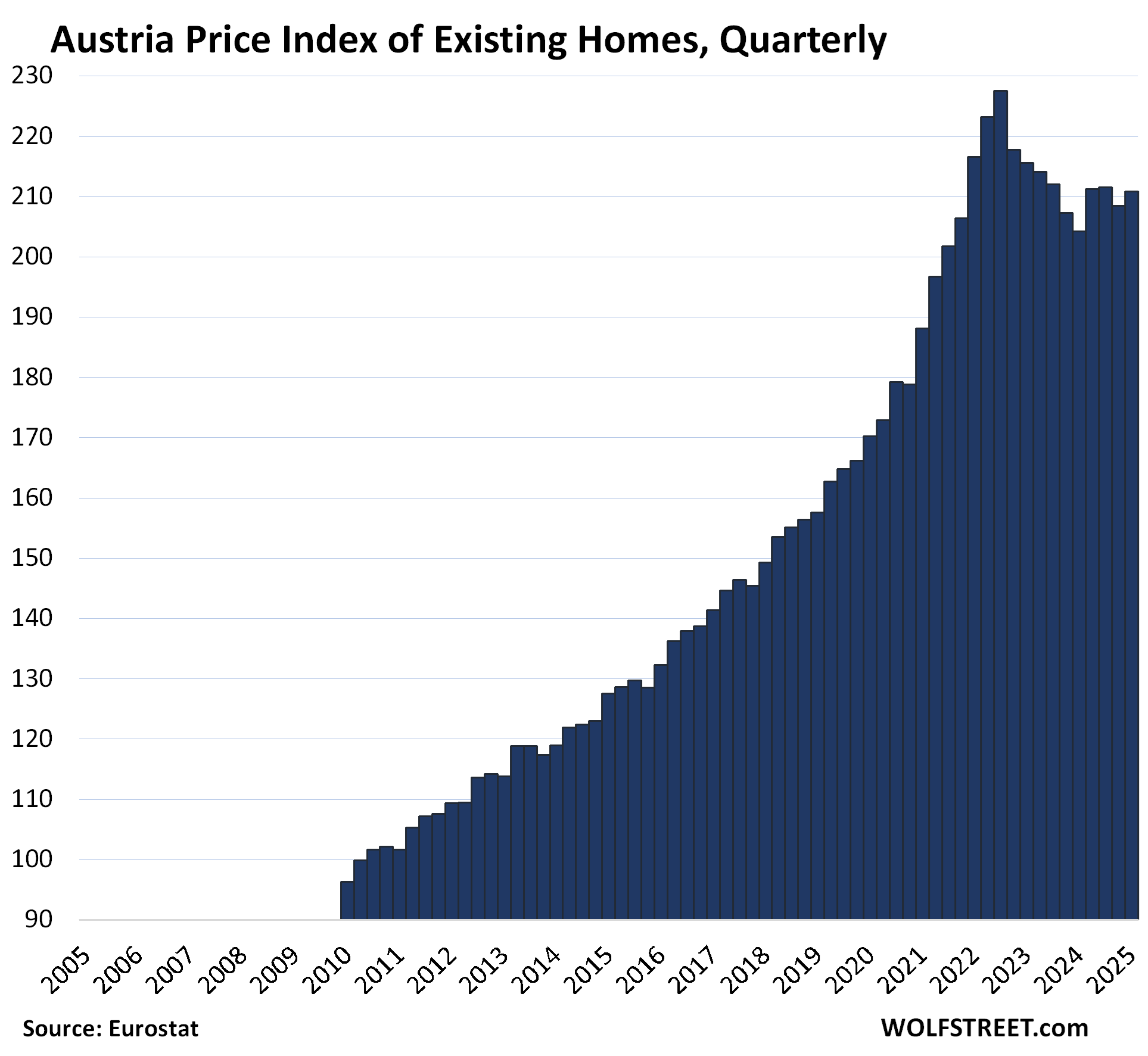
| France, Prices of Existing Homes | |||
| 2010 to Peak | QoQ | YoY | From peak |
| 39.0% | 0.3% | 0.4% | -6.5% |
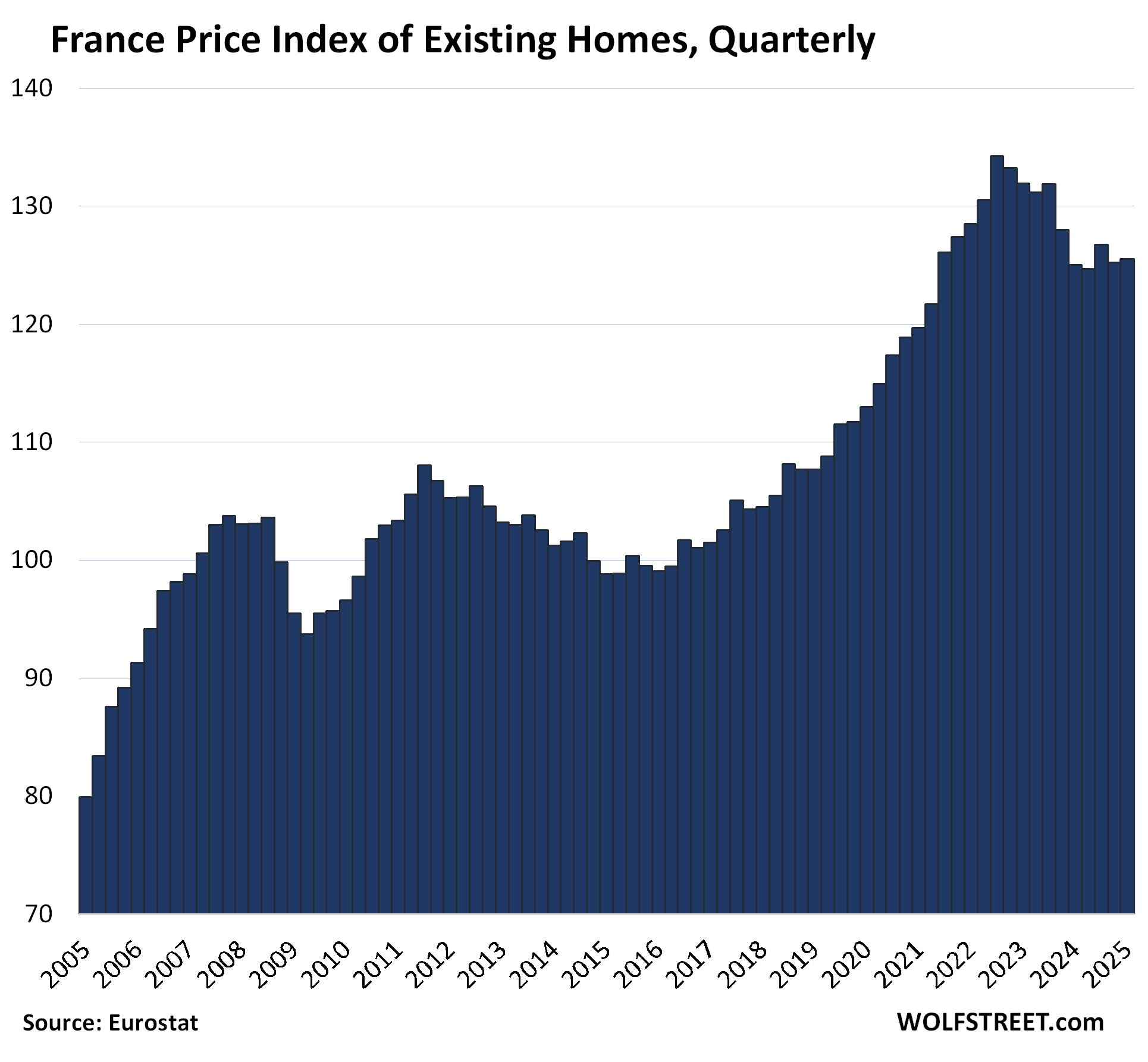
| Spain, Prices of Existing Homes | ||
| QoQ | YoY | From peak |
| 3.2% | 12.3% | -1.2% |
Home prices are almost back to the peak 18 years ago.
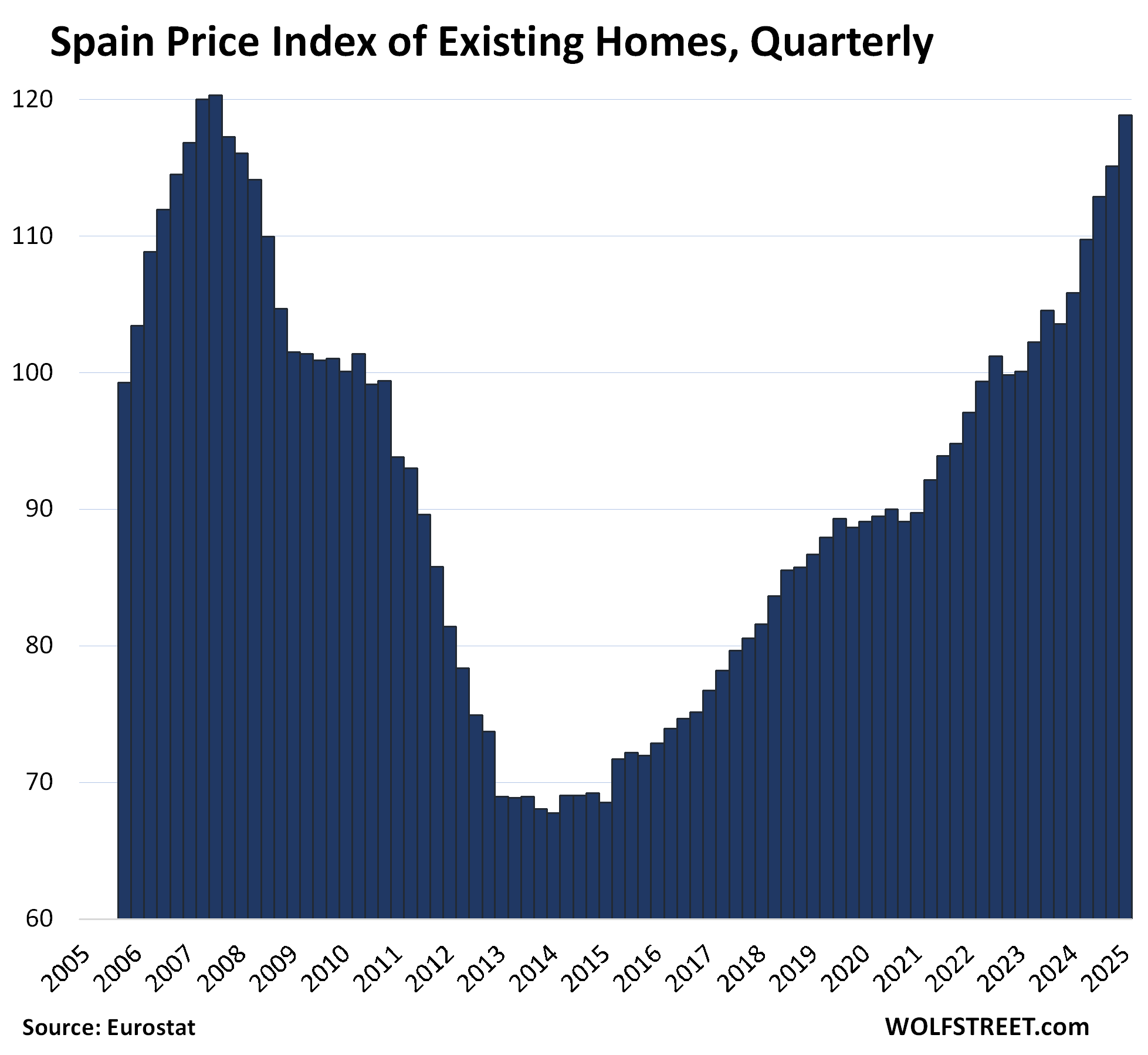
Of the 16 markets, the other 9 have made new highs:
| Poland, Prices of Existing Homes | |||
| 2010 to Peak | QoQ | YoY | |
| 107.8% | 0.5% | 6.2% | New high |
The Eurostat data for Poland begins in 2010:
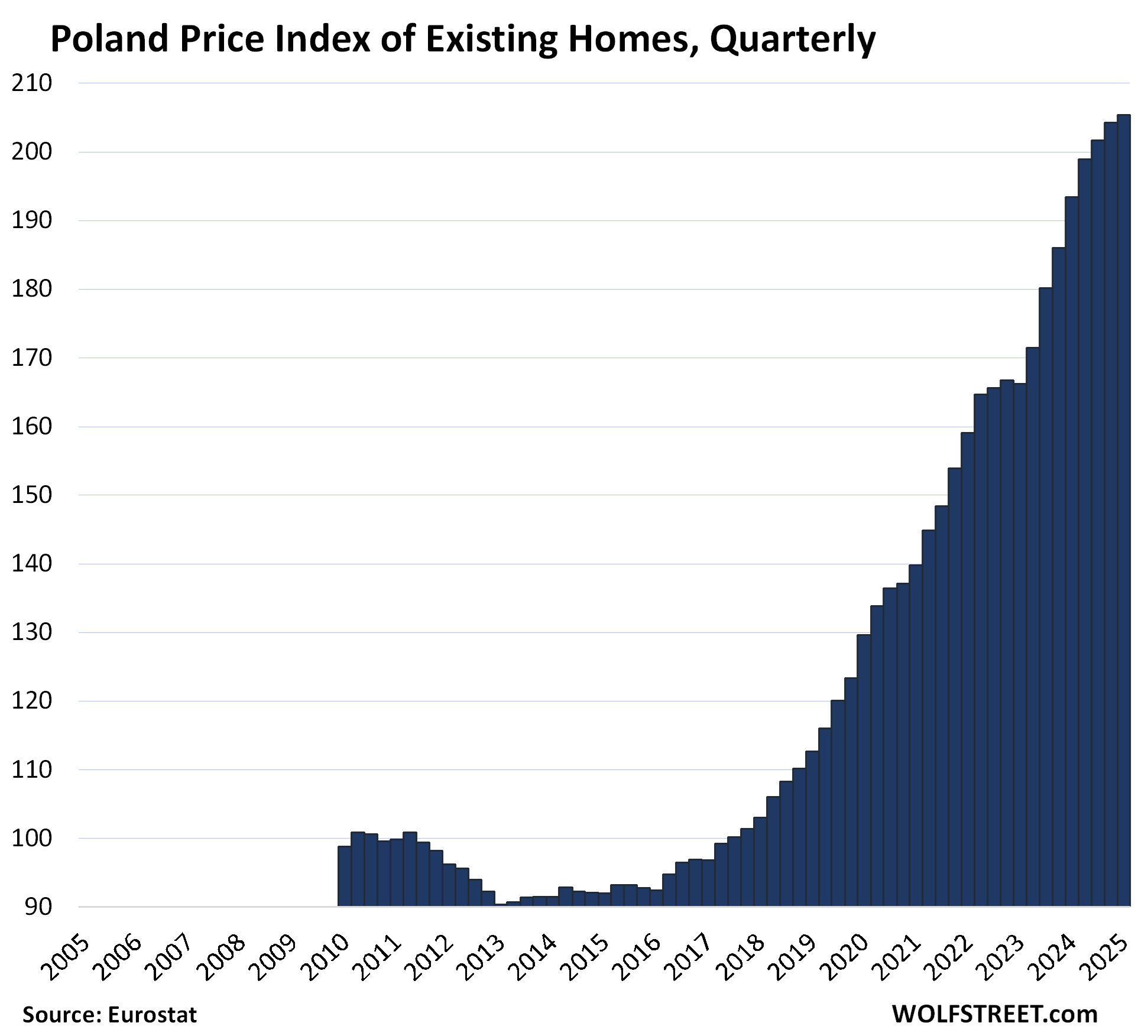
| Belgium, Prices of Existing Homes | |||
| 2010 to Peak | QoQ | YoY | |
| 58.2% | 1.4% | 3.6% | New high |
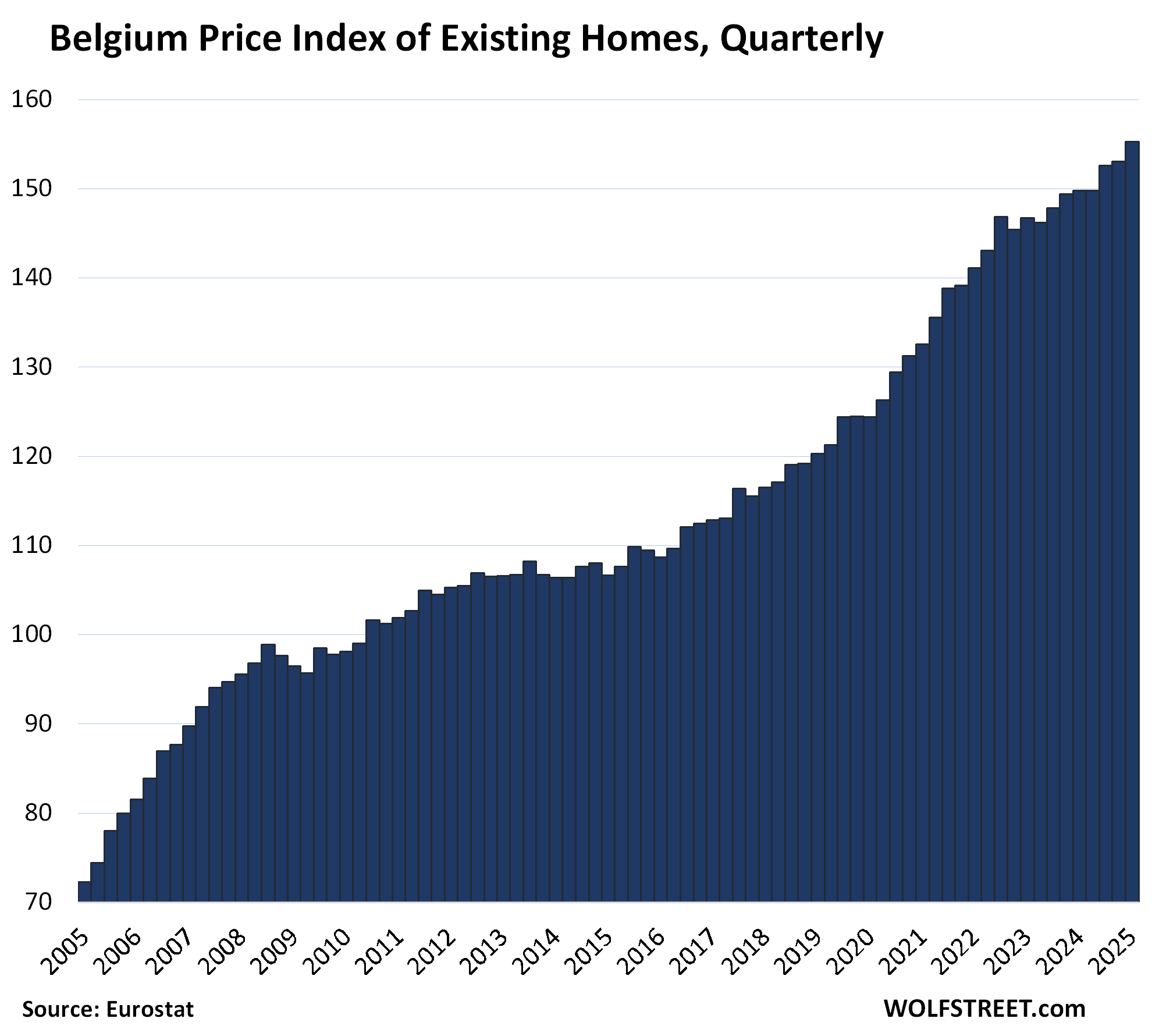
| Denmark, Prices of Existing Homes | |||
| 2010 to Peak | QoQ | YoY | |
| 65.5% | 2.1% | 8.8% | New High |
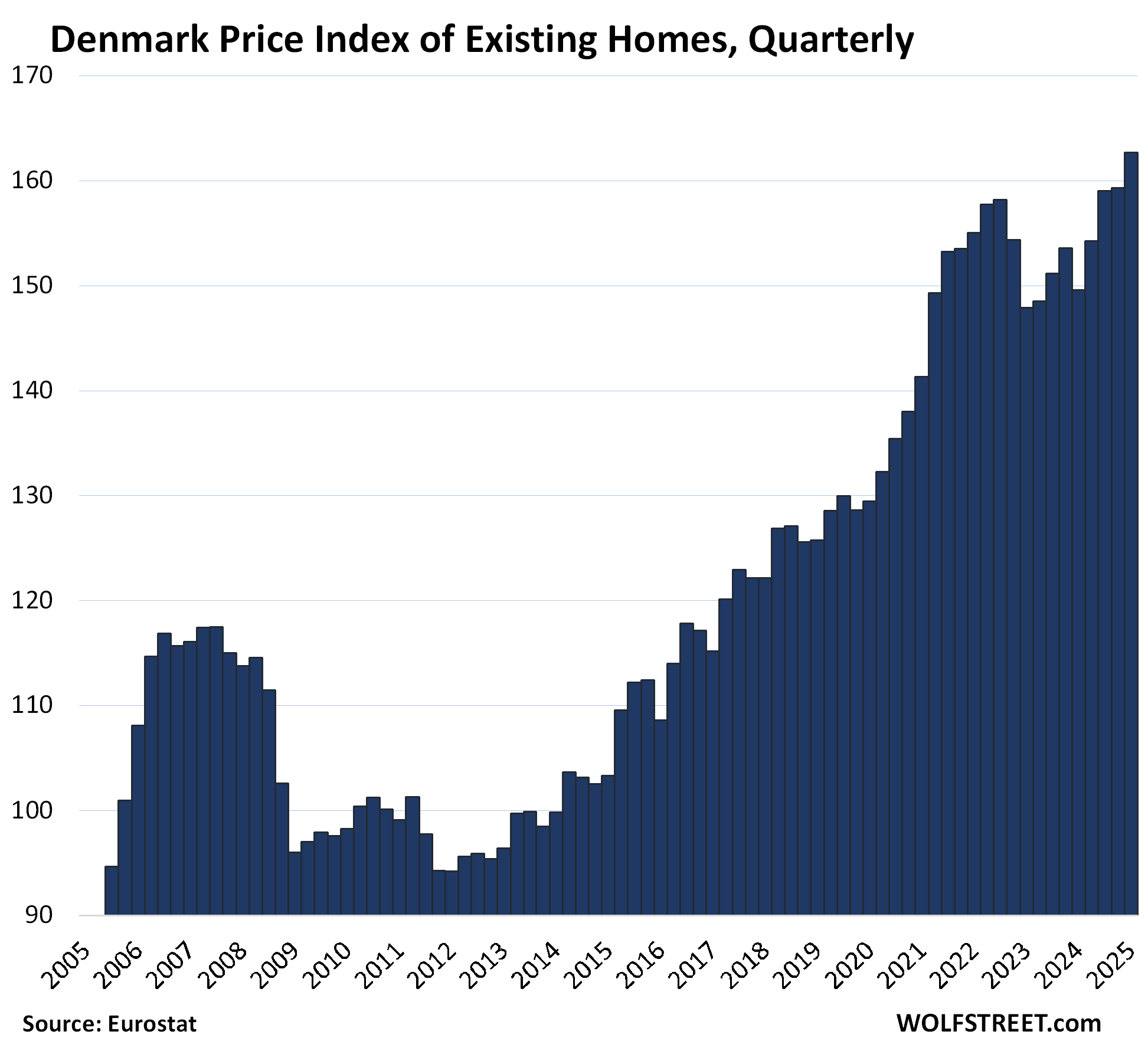
| Norway, Prices of Existing Homes | |||
| 2010 to Peak | QoQ | YoY | |
| 111.5% | 5.7% | 7.3% | New High |
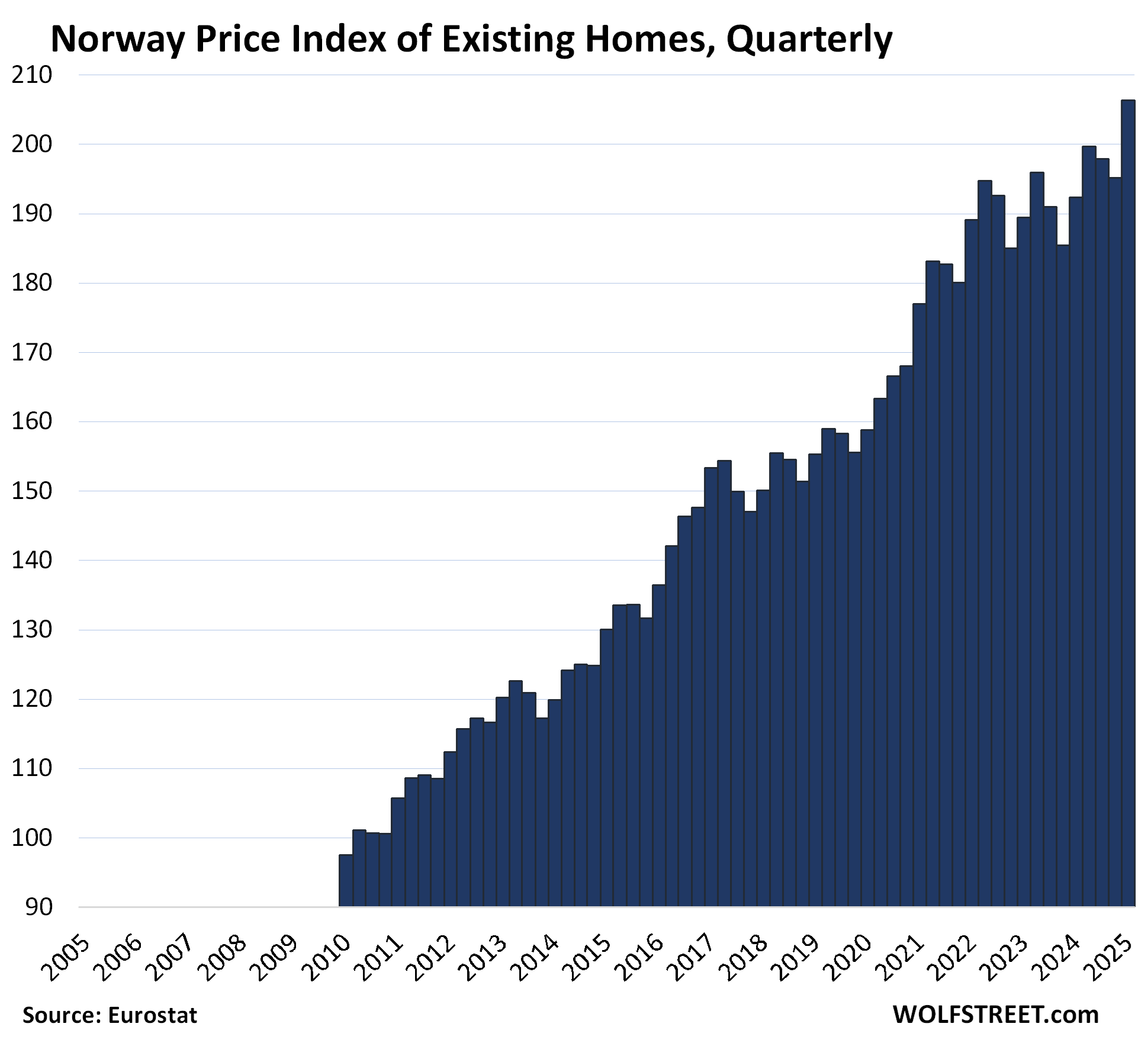
| Ireland, Prices of Existing Homes | |||
| 2010 to Peak | QoQ | YoY | |
| 77.2% | 1.1% | 9.1% | New High |
The Eurostat data only goes back to 2010, and Ireland’s troubles started earlier. But within the data, from 2010 to 2012, the index plunged by 33%.
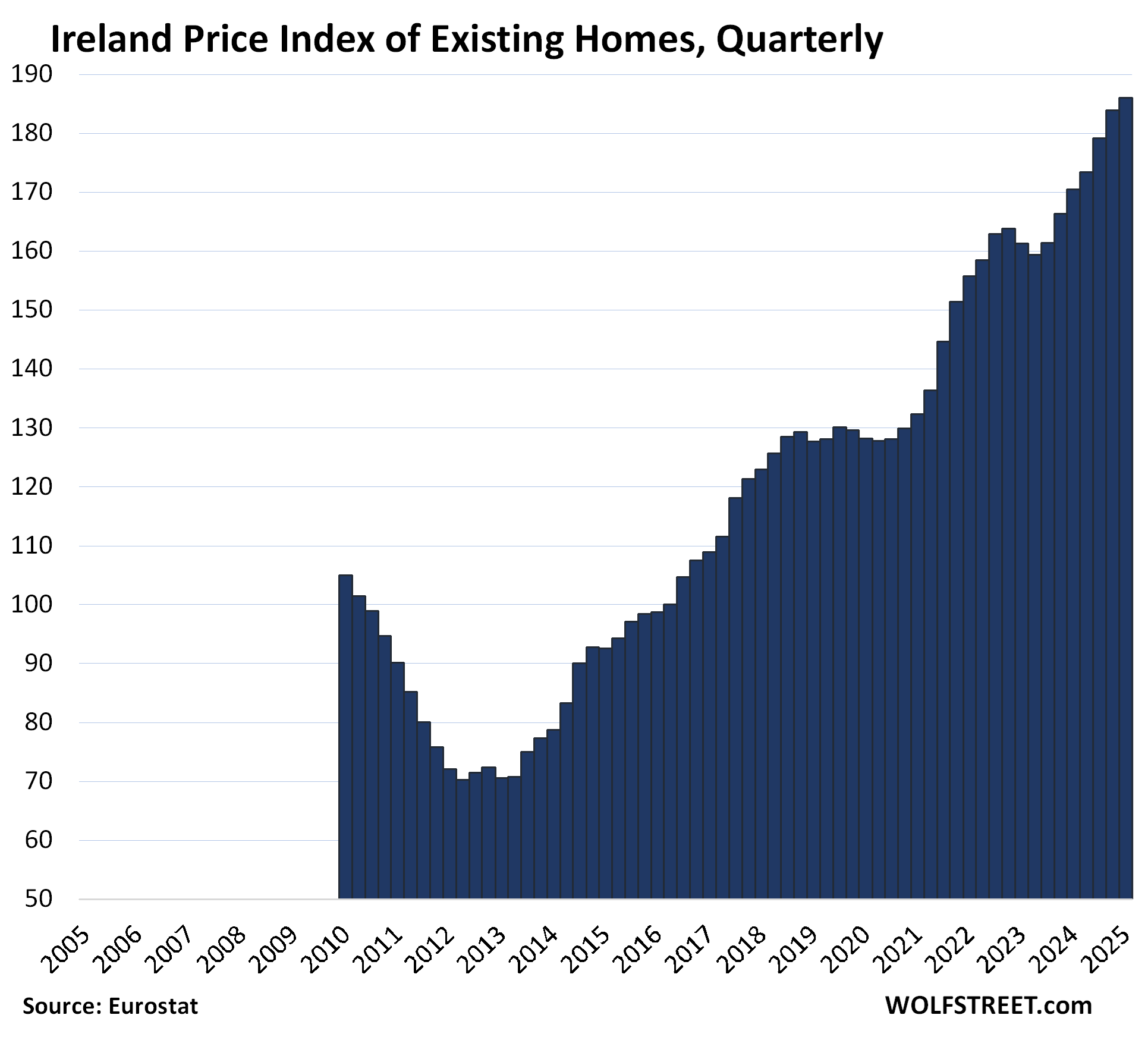
| Romania, Prices of Existing Homes | |||
| 2010 to Peak | QoQ | YoY | |
| 24.8% | 2.1% | 6.2% | New high |
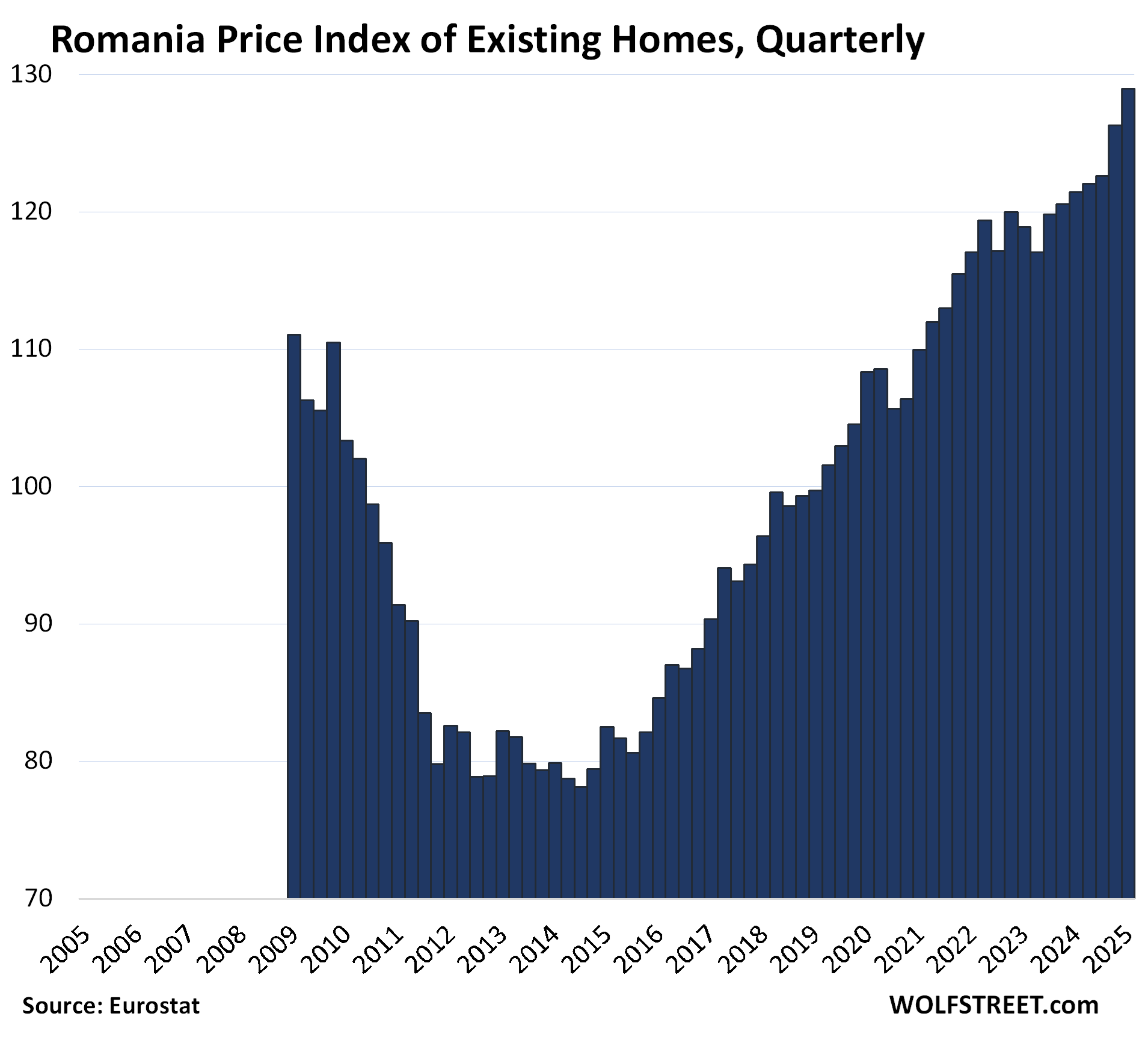
| Czech Republic, Prices of Existing Homes | |||
| 2010 to Peak | QoQ | YoY | |
| 145.9% | 2.2% | 9.3% | New high |
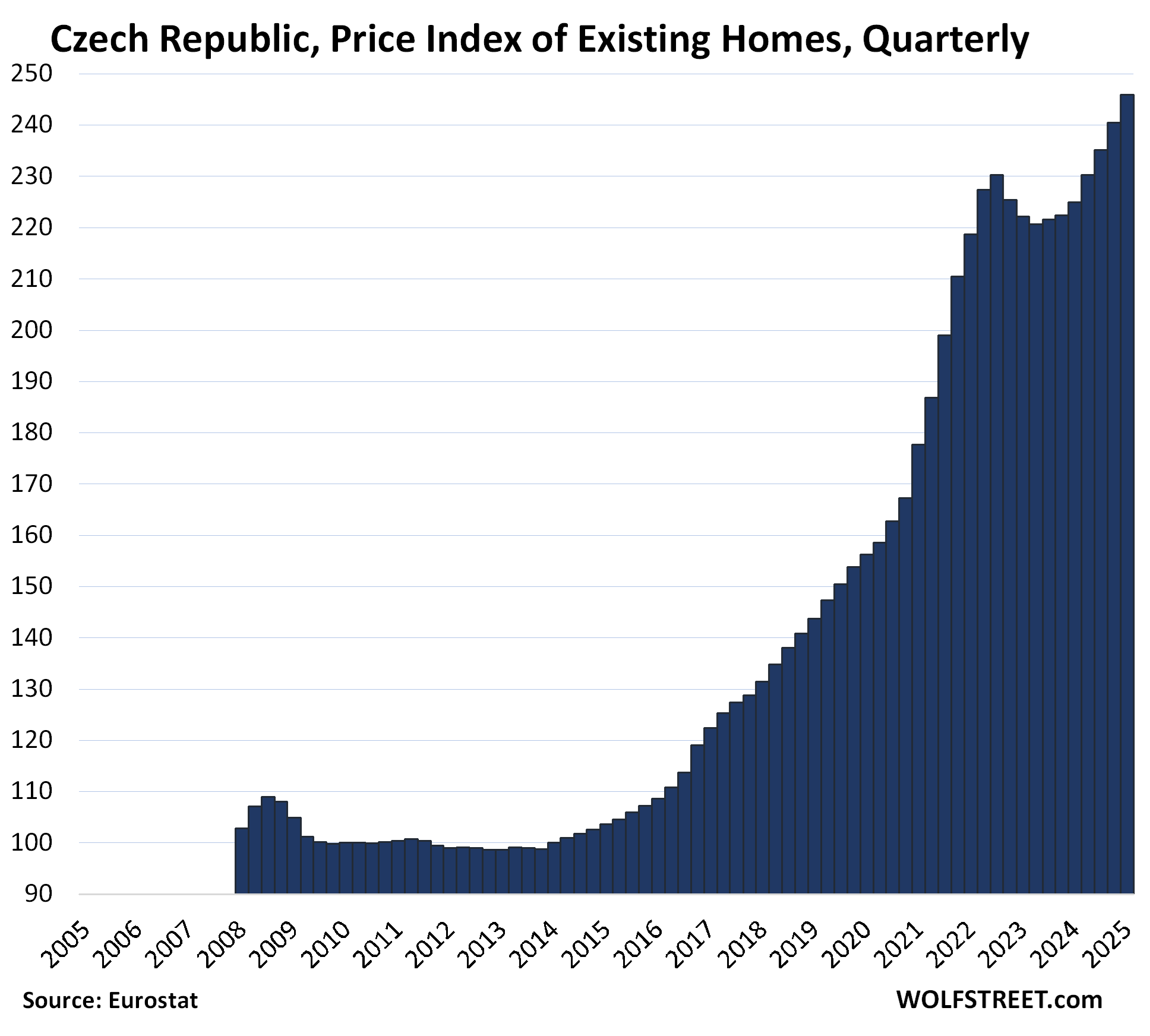
| Portugal, Prices of Existing Homes | |||
| 2010 to Peak | QoQ | YoY | |
| 139.1% | 5.3% | 17.0% | New high |
From 2010 to 2013, the index fell by nearly 20%. From that low point in 2013, the index has nearly tripled.
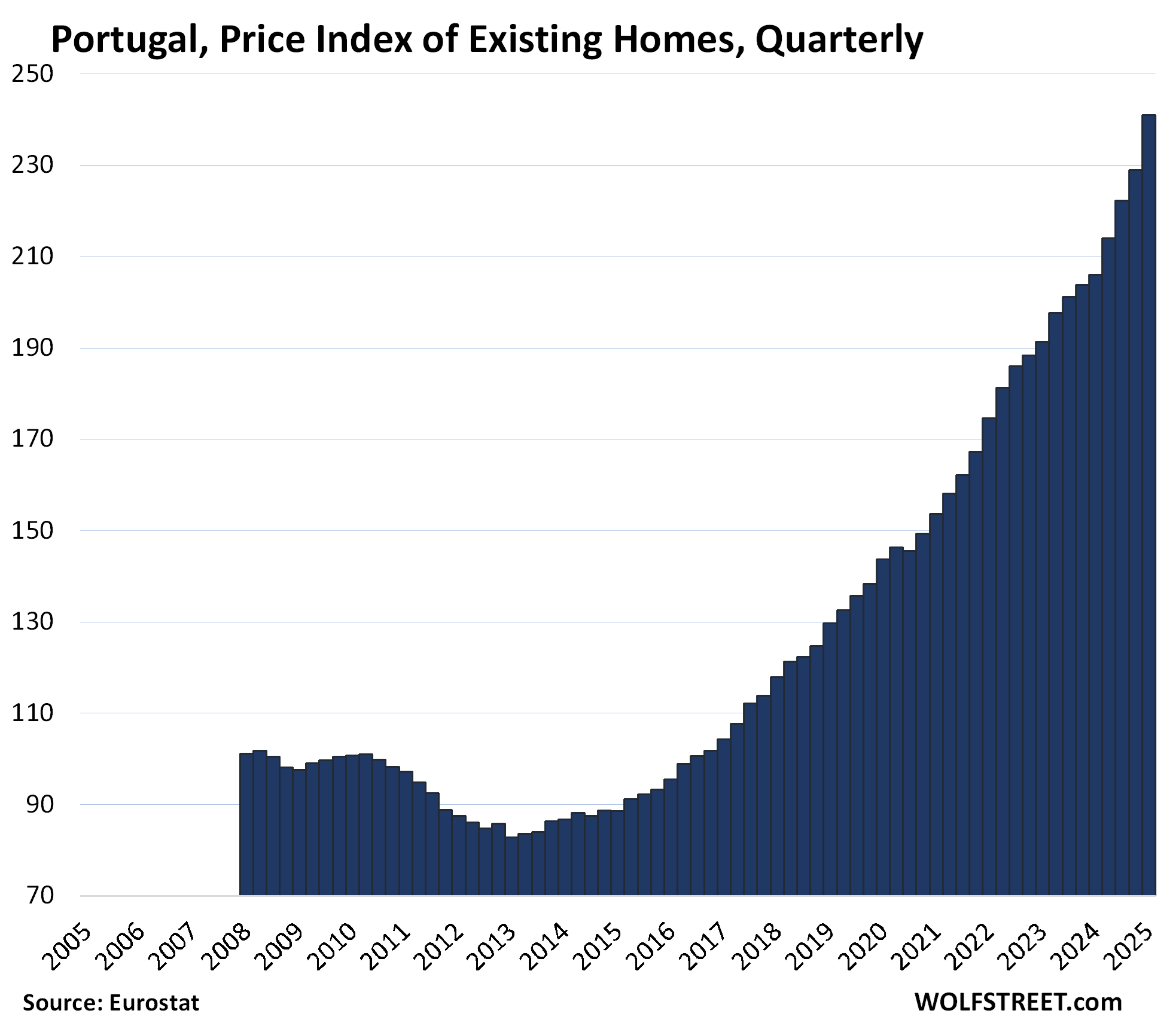
| Netherlands, Prices of Existing Homes | |||
| 2010 to Peak | QoQ | YoY | |
| 85.9% | 1.8% | 10.9% | New high |
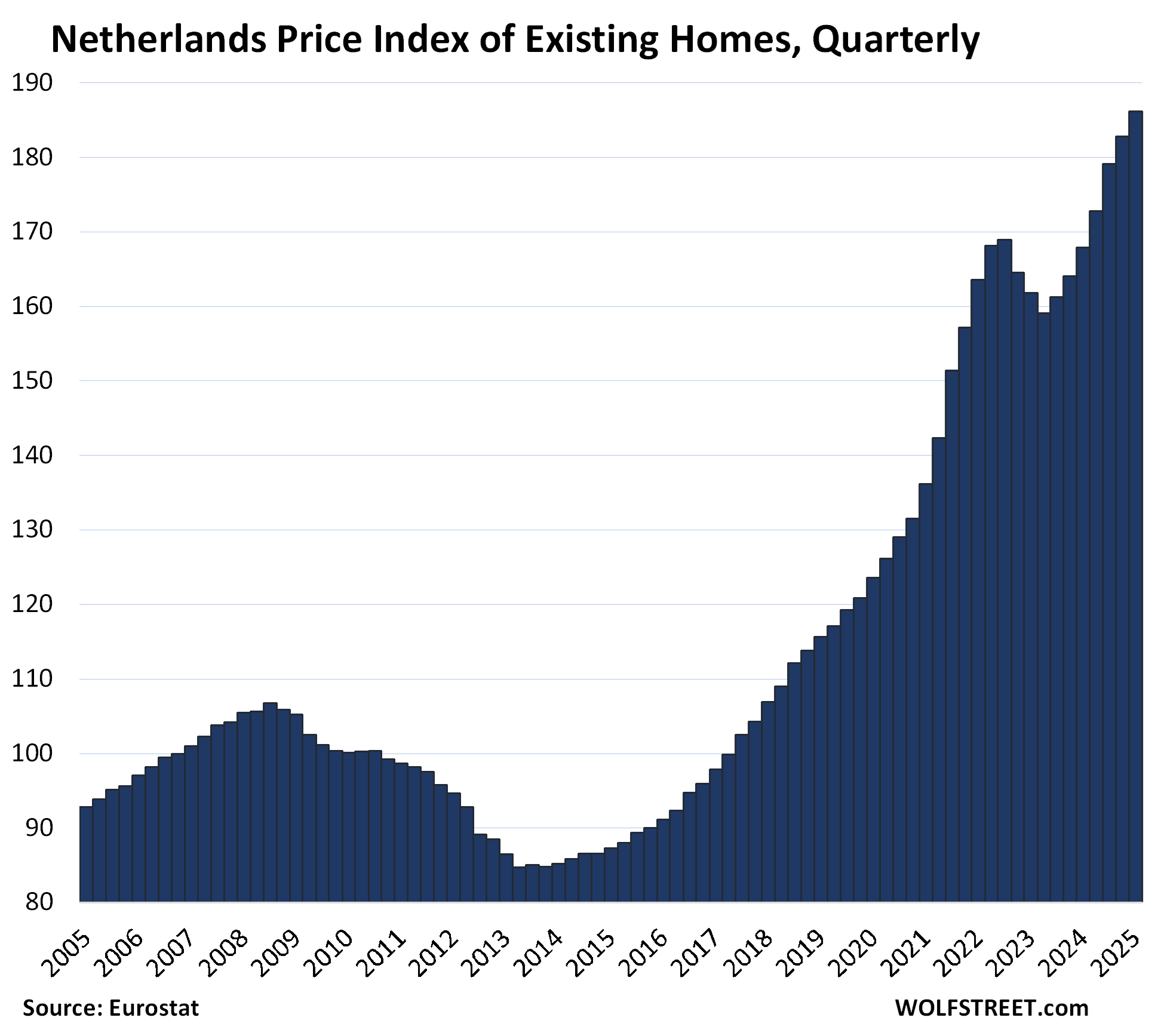
Enjoy reading WOLF STREET and want to support it? You can donate. I appreciate it immensely. Click on the mug to find out how:
![]()


No wonder the Portuguese hate the foreigners buying up all their property. Up 17% YoY after several years of YoY growth is crazy.
Yes, they come in with their American wealth and make the local housing market unaffordable for locals. Happening in lots of places. Not always Americans though, but Chinese buyers and others too. Mexico City has some protests going on over the issue right now (apparently popular with Digital Nomads). Chinese buyers also drove up local markets in the US, though that has cooled in recent years. There is a lot of the going around.
Yeah you see a lot of those Chinese buyers even now in SoCal, especially in SGV and Irvine, doesn’t seem to ever slow down unfortunately…
The entire swath from Monterey Park to Diamond Bar (east of downtown Los Angeles) has gone Chinese/Korean. I sold a house in Diamond Bar and ALL the prospective buyers were Chinese.
Only 5% of the house transactions are made by foreigners. Do not follow ruzzian propaganda against the European establishment.
That’s the average across the US. Foreign investors favor a few specific markets, and the purchases by foreign investors concentrate in those markets and the percentages of sales are much higher in those markets. But as I said, buying by foreign investors has cooled.
Portugal is being overrun with Canadians leaving Canada.
20% of the operations in Spain last year.
I dont know why you say this is propaganda. it is a matter of concern, at least in my country.
2024 data from the public notary ( solicitors? I dont know the actual word for notario in USA) points to 19,5 % of operations made by foreigners:
“Las operaciones efectuadas por extranjeros representaron un 19,5% del total de compraventas, quedándose por debajo del promedio que se registró en 2023 (21,1%).”
No propaganda here, just people who want to move to cheaper places
The %30 market buyers where chinese since 2010, and year after year negative effect of price growth because of this demand, even if its cooled to %5 had its damage done to the local market residents.
correction, for the US market
Just wanted to point out that the narrative of Americans or Chinese pushing up housing prices in markets like Spain or Portugal or Canada is exaggerated and strictly speaking not accurate. The reason that housing markets in many EU countries are up is the same reason why housing is up in the States – interest rate repression prior to and particularly during the pandemic resulting in near 0% rates. In the EU rates plunged significantly below rates seen in the nadir in the US.
If you need the hard data on this you can search for what proportion of home sales went to local v foreign buyers. For American buyers in Iberia for instance, it’s in the single digits as a % of sales. Not saying foreign money hasn’t impacted the market — it has — but the extent to which it has is massively exaggerated for domestic political purposes.
The locals in Canada can’t afford 3 million dollars in Markham, Ontario where I live for a new detached house.
you forgot that you are not the only foreigners buying in spain and portugal. In fact the ones who buys the most are from england, not USA.
you are speaking about the cause (QE) . We are speaking about consequences, people full load of money paying more than the local market and pushing prices up.
A 20% of operations…
the worst, the brunch places replacing our gastronomy places. what in the actual heck make those people think their eggs and toast are better than jamón serrano and tortilla de patatas. It is just not ok. We must protect at least the jamón.
Mind you – the market value of even a commieblock in post-socialist countries is now higher than that of the average house in a lot of Southern European cities.
So it’s not just the Anglosphere, I’d expect a lot of Polish, Czech and Baltic people to buy a first- or second home in a sunny – but poor – Mediterranean town. Both pensioners and the remote working crowd.
Bingo. QE from the European Central, pumped up the whole of the EU, and amplified the wealth in the UK and Northern Europe driving the second home phenomenon in Spain and Portugal and Greece.
Portugal real estate bubble is crazy. The prices in Lissabon are inflated even more than the article suggests. The prices in the country side are quite low but the appriciation in the costal cities, especially Lissabon is insane.
Lissabon is more expensive than Berlin or Vienna but salaries are half. Golden Visas and remote working expats + AirBnB + over tourism + prices go up mentallity.
Portugal launched new immigration policies & thus Lisbon became new favorite of Chinese. Not a surprise. Before it was English & Americans whose housing market is very different from Chinese housing market.
Starting Dec 2024 / beginning of 2025, many Chinese realtors have talked about how cheap home price in South County comparing to Irvine & Newport Beach on Chinese social media like WeChat. These realtors are mainly from China some are Taiwan during recent years & weren’t realtors before they came here. Guess what? Recent article from Orange County register by Jonathan Lansner – all those areas have the highest gain such as San Clemente, Mission Viejo, San Juan Capistrano. Chinese started to buy in Dana Point since 2020 so only 1% increase. If you know how these Chinese make $$ by selling 🇺🇸 products to Chinese via WeChat & not paying income taxes & buy homes with cash, you will ask why we allow this happen? If you want to know what will happen to these neighborhoods down the road, just look @ neighborhoods along 110 freeway around downtown between (1950 – 2000) absolutely geto before Latino took over (1st round of Chinese buying back in 1949 with many fled china) & East LA (new Chinese immigrants over last 20 years). Energy / vibes are like zombie no interest in 🧠 (consciousness) but only $$. It is not cooling down in Orange County because of Chinese buyers who compare our housing market to those of big metropolitan areas in China. They think our housing market is cheap even @ current pricing! This insanity is beyond any rational minds can comprehend unless you understand the culture & know the history of housing market development in China since 1995. American dream of having a comfy cozy home might be dead unfortunately for many especially younger generations who want a lifestyle like their grandparents generation. The issues are not even whether young Americans are hard working people or competitive enough, not whether renting is not as bad as owning, it is way more scary the deeper we dig in. The chats shown in this article also reveal a concerning picture – where Chinese move in, where the pricing skyrocketed in EU. You can also see the time of such crazy increase is perfectly timed by the moving time of Chinese – yep if you follow info about Chinese migration, you see wherever it is their new popular place to move in, you bet housing market will go crazy. Housing market over the last 20 years is no longer the function of economic factors such as demand / supply, Fed policies, etc. it is a tool to reshape the world politically. when homes are no longer for living nor for healthy investing, but became a tool via manipulating stupid irrational buyers and rewarding speculators, you know it is something else behind it. We patched 2008 crisis not fixing it. Why?
Until the Fed no longer exists, and especially since they still have thousands of billions (trillions) in mortgage bonds on their books, it can’t be said that they dont influence, and many feel, negatively, the housing market. The fed is not needed at all, see Massie HR 1846 bill, and yes that means Congress shouldnt set rates either.
There are a lotta ex-Pat communities in the Algarve region of Portugal – heavy percentage of which are Brit. I looked into buying into property there several years ago.
It should be noted that these Euro countries(in respect to foreign ownership) all have different tax/regulatory environments (France, for example, has a social welfare tax as well as full income tax for all earned income if one lives in a property over 179 days/yr), initial investment requirements (e.g., medical buy-in, bank deposits), prohibitions on where property can be bought, etc.
There is a definite policy undercurrent of trade-offs between the economic benefits/costs of foreign buyers versus continuity of culture.
The government/legal system can also be a maze that is distinctly unilateral in its decision-making: I learned this the hard way in Paris.
Low rates caused quite a bit of distortion in most markets.
Can we blame all of these on supply shortages too?
In Europe? In the large urban centers maybe, but Italy is still full of $1 homes. And not just Italy – the countryside is still super affordable throughout Eastern & Southern Europe.
In many case it’s more of a “move to the city” bubble rather than a housing bubble. While suburban & rural living is gaining huge popularity in Europe too, at the same time the largest cities had a population growth of +10% (sometimes +15%) in just 15 years. A lot of that is immigration from the Middle East, Ukraine, the Balkans, other EU countries, etc – demand that is kind of unpredictable.
Move to the City seems to be a trend in a lot of places around the world these days. Japan and South Korea are probably the most blatant examples, but the US has dealt with the same issue. I saw a US map a few years ago that showed how jobs sprang back in larger metro areas within a few years of 2008, while a lot of rural counties took a decade to get back to parity. I’d be shocked if Europe hasn’t been dealing with similar dynamics, especially given how their population pyramids are shaped these days.
The thing people forget is that, even in the United States, with only a few exceptions, you can drive 40 miles outside of our large cities and be in the middle of nowhere.
There’s plenty of space. It’s just that people largely want to be near the action, and the jobs are in dense areas, so even if you live outside, you generally have to commute into crowded areas.
…would also add the importance of the communications ‘digital divide’ continuing to afflict rural ‘Murica, along with the continuing contraction of medical/hospital services available to those same areas/communities…
may we all find a better day.
“I saw a US map a few years ago that showed how jobs sprang back in larger metro areas within a few years of 2008, while a lot of rural counties took a decade to get back to parity.”
That is where most .gov subsidies go, are you surprised? Higher Ed, Healthcare, Tech (though they haven’t been performing to great with 0% rates gone). Perhaps that explains some of the anger people feel?
The $1 homes thing isn’t really the bargain it sounds. Even in these rural areas, there are much stricter rules on habitability relative to the US, and all of these homes require significant renovations, by highly-regulated construction companies, to receive a habitability certificate.
It’s not like the US where you can hire a Mexican crew to redo your bathroom in cash. Any change requires an official form submitted to the local government, approval by an architect, etc. Then you have to hire licensed contractors (8-hour slow days with paid hour of lunch) to complete the work. In my country, if the repair takes longer than a day, you have to pay for a portable toilet on the premises, rather than just letting them use your in-hoke toilet. The Europeans are kings of hidden charges and taxes.
Interesting data for Europe, wonder if majority of their population have the same house humping mentality that housing will always go up and a sense of shame (or throwing away money mentality) in renting as a lot of people have in the US. At least they don’t have this beast call the 30yrs fixed mortgage to harden their belief..
That is exactly the mentality we have in the Netherlands. Even 30yrs fixed pay-interest-only mortgages with government subsidy on the interest. Tough market for starters/young people
A big difference in housing markets is if the buyer can “assume” the mortgage of the seller, which sort of happens in Canada but never in the US. It would be nice to see the most recent average home price in the various countries discussed by Wolf. I wouldn’t mind buying a house in rural France, Germany, Italy, or Greece, away from the invasion.
This is a good solution, but if you are retired or have enough money, it is difficult to find work in small towns and villages in Europe.
Property prices in the provinces of European countries have not yet jumped to insanely ridiculous levels.
A good solution? A good solution for what? Isn’t there a certain point in life when you realize you’re not accomplishing anything by buying property? Maybe you’re not there yet.
“Be as simple as you can be; you will be astonished to see how uncomplicated and happy your life can become.”
– Paramahansa Yogananda
V,
I can get down with that quote, but especially after having found near-certain financial security, best obtained by owning a home. Sorry, but I won’t be happy living on the streets.
Yes, they do. If I had to guess (maybe Wolf will completely contradict this with hard data, but nonetheless) the avg European is very risk averse and housing is seen as safe. Most EU residents I know think housing or savings account, rarely stocks. The average American, however, very frequently owns equities — in addition to investing in whatever else. It’s the same story in Latin America and Africa. I won’t speak to Asia b/c I would imagine a lot of variability on this issue between the very different countries, think Japan v Vietnam etc.
Either conventional housing or other kind of property. Agricultural land, weekend house, forest, parking lot space and so on. But even when it comes to investment funds, commercial real estate funds win by a large margin in most of Europe (went bust btw – just not as theatrically as in China or the US).
It just seems like people trust the land register will do a better job in keeping track of ownership titles than brokerages. I’m pretty sure there was at least 1 or 2 major scandals with stock exchanges in every European country in the past decades, so the confidence towards the financial system is pretty low.
Plus trading fees and taxes generally do not favor individual investors – it’s often daylight robbery.
The UK also has suffered from the ‘house humping mentality’ (good phrase) for most of my adult life.
I can’t count how often I’ve heard the same stock phrases trotted-out:
‘ You can’t go wrong with bricks and mortar ‘
‘ My house is my pension ‘
‘ Renting is like pouring money down the drain ‘
A key differences is that one cannot prepay a mortgage in most of the EU. If you move and sell the house, you owe the expected interest on the mortgage (or an early repayment fee of an equivalent amount). Adjustable rate mortgages are also much more common.
Another big difference is transaction costs due at closing that are much higher than the US and ongoing costs that are lower, discouraging transactions. For example, in most of Spain you’ll pay ~10% of the value of the property the day you buy it, mostly in taxes. Meanwhile, holding costs via property taxes are relatively low compared to the US.
In general protections are very strong for renters. Think whatever most liberal place in America times ten.
As an example, in the EU country I live in:
Once you’ve entered a lease it can only be broken by the renter in case they want to sell the house or move into it themselves. They can’t just refuse to renew the lease–which becomes perpetual after the initial 12-month period.
If the landlord wants to end the lease for one of the reasons above, you must give the renter 6 months notice. If you have kids, it’s 12 months. If a renter is pregnant, the 12 months only start 3 months after the birth.
Landlords are limited on the yield/profit they are allowed to realize, so rent prices are closely tied to ownership prices. You can’t just raise the rent to whatever you want.
Leases are only drafted by licensed real estate agents, so there is a standard format and the “rules” from above must be followed by the landlord and they can’t add random abusive clauses.
Finally, remember that historically it’s confusing for and more difficult for most Europeans to invest in other assets like equities. There isn’t vanguard and fidelity offering you signing bonuses for no-cost brokerage accounts and free trades through a convenient internet portal. Rather, physically visiting a bank branch and paying 10eur to execute a trade, and then having any gains and dividends taxes at typically much higher EU income tax rates. There isn’t a 15% rate for long-held capital gains, for example.
Truly finally, in most cases government outlays aren’t closely tied to the value of property as they are in the US. A school in a rich area isn’t better resourced relative to one in a poorer area, for example.
There are a lot of differences between US and EU.
In EU cities are much more compact, you walk to the school, walk to the grocery store, etc.
Because of that US is mostly flat (single family homes) as you drive everywhere, EU is mostly multi family homes.
That makes supply lower (as no land in the cities), and demand higher (good location means 10-15 minutes walk to school, park, restaurants, etc.)
As for price, for Poland ratio between property price and average salary is even declining last few years.
Rent to price is 7-8% for last 20 years, so there is no bubble.
Additionaly, government regulations on buildings energy-efficientcy made old property cheaper but the new one grown in price.
Completely agree with this, and you see it in real estate listings. In the EU a key “feature” is convenient access to services (school, pharmacy, doctor, public transit) whereas in the US there is a strong emphasis on seclusion and privacy.
My apartment in central Stockholm, Sweden is up 1200% since I bought it in 1993. I wouldn’t mind seeing prices fall.
In gold, your apartment is flat. Since 93, gold’s up 1000% in USD, and SEK lost another 17% to the dollar. Sweden tax capital gains?
If you used a mortgage — nice, you beat this debt game.
What about the apartment priced in S&P 500? What about gold priced in S&P 500 over this period. Gold is up 730% over this period, the S&P 500 is up 1,300% over this period. The apartment is up 1,200% (according to Volvo P-1800).
So the apartment beat gold and is just a little behind the S&P 500.
But pricing one asset in another asset… does that even make sense? These three are very different assets with very different costs and risks.
Yes, I hear housing bulls constantly say prices won’t go down because the price of homes have tracked the value of gold.
I then ask them how many people they know buy homes and get paid their wage with gold.
“…the silver apples of the moon, the golden apples of the sun…”
-yeats
(…but what about the oranges?).
may we all find a better day.
If what we’re measuring is return then this is the best we can do — we have to compare to something — inflation, risk, opportunity cost etc — and adjust for that in a universal way, eg USD.
Productive businesses (eg. DOW, S&P) will almost always and *should* crush the return from shiny rocks and 4 walls and a roof in any sane world. But people being people means weird things happen from time to time and quite often
I suppose that is the reason for diversification.
I have found that if something is touted ass a sure thing…..it is a warning sign that it not a sure thing….most likely very risky.
But then again, i like yo play it on the conservative side.
> Productive businesses (eg. DOW, S&P) will almost always and *should* crush the return from shiny rocks and 4 walls and a roof in any sane world.
You talk a lot of sense Market observer, but 4 walls and a roof is a consumable requiring lots of maintenance and eventually replacement. The plot of land it sits on and it’s location is where the enduring value is.
what will happen in nz and aussie ?
Are these in USD figures or local currency figures?
1. Eurostat doesn’t do dollars.
2. These are not currency figures at all, but an index where the index value was set at 100 for 2010. The local indices are constructed from local currency, which for most of these is the euro, but for some it’s the local currency.
Most of this is simply how inflation robs us all, while the parvenu of new wealthy frantically ship their capital around trying to outrace the burning flame of money in the modern era. And this goes for everything. Costs will rise, while means of production cost more in terms of the coupons, but reality is just what it is, a slow or fast burn. California used to be cheap, now it is super expensive, the rust belt still is cheap, but the wreckage was immense. The hardest part is that while retired, prices will continue to rise, while the fixed income you live on shrinks. I now think we will no longer see independent living for retired people in America for most of the bottom 75%.
But, like so much, we build for maximum expansion. We price for an infinite number of people with money to spend. Today’s interesting number, the casinos on the strip in Vegas now target a median income of $93k per person for their guests. Which is in the top 10% of earners in America. In short, as we get stupid, we think the rich are the market. And in a lot of cases, they are the only ones left standing.
I keep hearing everyone complain about where they are, while thinking there is a mythical Shangri La of cheap housing, cheap healthcare, and cheap wine. The entire world is the same.
The really funny part is that so many places price everything on aspiration, and the actual prices of real estate away from those popular burning flame places are falling in real terms. Want to live remote? Go ahead, no healthcare. I would note that wine is the cheapest in real terms in history, and that wineries are going bankrupt on a regular basis. So you get that much, thanks boomers!
I find it hilarious that Doctors keep moving to find that mythical pool of rich people to employ them with gold plated healthcare. I would note ten seconds with the AI shows 46% of people in Arizona are on public healthcare, 9.8% are uninsured, 1.5% are on Tricare, and that leaves just 43% covered by all forms of private health insurance. For 8 million people. Now, doctors are going to have to realize that the average practice will have 50% public healthcare. And that means they won’t make anywhere near as much as they used to do when it was mostly private insurance.
Now, we might just as well socialize it, because guess what- we already have!!! I love how stupid America is getting. The boomers have moved to Sweden,with their socialized medicine, voted to kick out the cheap labor, and think that their investments will grow to the moon.
Someday this war’s gonna end…
CAM – …appreciate your observations. This one is particularly eloquent, elegant, and a pleasure to read, even with its doubtlessly unpopular conclusions. Best-
may we all find a better day.
Smart post CAM.
“In short, as we get stupid, we think the rich are the market.”
See, also, auto industry…
” Now, doctors are going to have to realize that the average practice will have 50% public healthcare.”
It has been that way for quite a while…but med schools have continued to abuse the absolute *crap* out of their gate-keeper function (tuition inflation).
Prices are all about supply and demand. California is the most desirable state in the US to live and there is far more demand than properties which is why real estate pries are what they are. California already has more than 40 million people and continues to grow and would be the 4th largest economy in the world if it were its own country.
If you look at the inventory in CA, there is absolutely no shortage of homes for sale as documented by WR may articles.
SFO has seen decreased pricing of 20% plus more from the peak.
There have been no house price declines of any real significance at all in California and nearly all houses are in the $1 million to $10 million range regardless of local or quality. A tiny little drop of 20% on a $2 million house would only bring it down to around $1.6 million and one would be very hard pressed to find that.
“…tiny little drop of 20% on a $2 million house”
🤣🍾 $400,000 out the window, $350,000 underwater, due to this “tiny little drop of 20%” on a house they paid $2 million for. Glad people keep their sense of humor about this.
@SoCal,
Can you not read? Prices in SF are down 15% for single family homes, and condos are priced as they were in 2015, literally no appreciation for the last decade. Prices can and do decline in CA, as they can anywhere, when prices become disconnected from income. People in Tokyo said the same things you are saying now in 1989, look how that worked out.
Yeah and how much did the price run up relative to other markets before that 20% drop?
We’re seeing new RECORD HIGH PRICES for a number of houses in the wealthiest areas of Los Angeles County this year.
Didn’t Trump or someone institute a law where no one from outside the country can buy property?
NO, just some stupid farmland and military base stuff. Just imagine how fast house prices would drop if every single house had to have a legal resident, or be taxed at high rental property taxes. And that would be stunning.
LoL. And SOCIALIS<M. Uh, Canada did it a little bit.
Primary residence plus a vacation home is fine. Anything above or beyond that should be taxed punitively to discourage speculation on residential housing. If you want to invest in real estate it should be for multifamily apartments or commercial. When people can’t afford a basic place to live and to put food in their mouth is when the real revolution will begin. I hope I don’t live to see it.
Yeah, my little sister is picking olives on her farm in Spain.
And now, in Mexico, they are threatening to ‘off’ Americans who live/move there – no joke – there was a demonstration’s in Mexico City. That’s a way to thank us for all the millions that have immigrated into the U.S.
Yeah, people are stupid and look for scapegoats everywhere.
Howdy Youngins. To ZIRP or Not to ZIRP?
That is the question folks.
Interest rates will continuing rising throughout the US economy.
Won’t matter this time, watch them try it again and rates skyrocket. Rates would already be at 0% if they thought they could get away with it. 2020 was the last of the print to keep the rich rich BS. Unless perhaps aliens invade and that requires printing a few trillion……….
What if declining populations drive up housing prices? As mentioned above, what if people want to generally get ahead of the curve and, seeing rural/ex urban areas shrink, there is then increasing desire to go urban to where the stuff to do / work is. In the past with population expansion, you could buy out in the burbs and be confident stuff would grow around you … now that’s not the case so … move closer and closer in…?
Declining populations are only in countries with higher levels of development. The world population continues to grow. What we are seeing is a migration of lesser skilled peoples into places where the populations have declined. This is what scares the status quo; as the racial mixture and cultures change the older society has to come to grips with being assimilated.
KGC – this. The effects of human population ‘surpluses’ and ‘vacuums’ are historically-abundant, the reasons for each, legion (…expanding to the limits of their contemporary techs/governances to successfully sustain them, then contracting upon the overshoot, for one…)…
may we all find a better day.
As Peter Griffin once said (while riding an Elephant): “Look, it’s the two symbols of the Republican Party: an elephant, and a big, fat, white guy who’s afraid of change”.
The only place on earth with a growing population is sub Saharan Africa. Everywhere else, population is declining or will decline in a generation.
Thailand, Mexico, China, India have well below replacement level birth rates.
I’m not an economist, but wouldn’t declining populations reduce home prices? Not that the population is declining.
To your other point, the suburbs in Twin Cities, MN seem to be growing and becoming urbanized, while the exurbs are being suburbanized. Two lane highways like I-94 eastbound into Wisconsin are being expanded. I-494 is 6 lanes. US-12 westbound is growing from 2 lanes to 4.
4+1 condos and some midrise apartment buildings are going up everywhere in the suburbs. The Twin Cities are built out to the Wisconsin border. Somerset, WI and surrounding areas are turning into commuter towns. Now developers are building westward because the east side of the Twin Cities is full.
Except European population is dropping yet their prices are increasing?
It’s a very interesting question. Given AI and remote work, it’s very questionable how much jobs will still be overrepresented in urban areas.
The other factor often ignored is changes in household structure. A FAR higher share of the population is now living in much smaller households. Think about a typical family today. Grandparents divorced–one cohabitating with the new spouse in some retirement destination, the other an elderly single fading out. The parents are divorced or never got married in the first place. Kid lives with the mom. So you have 4 property units occupied by a three-generation family that 70 years ago would have all cohabitated.
Southern Europe is full of 4-5 bedroom homes built for a prior generation with lots of kids and multigenerational families, and doesn’t have nearly enough studios and 1br units to match the current demographic reality.
Interesting article from Realtor.com today…who knows, in this nutty world, maybe if they relist next Spring, they will get beyond 2022 prices…I wouldn’t bet the farm on it won’t happen. On the other hand, this can also be the start of chase the market down avalanche..
“Delistings Surge Nearly 50% as Sellers Who Can’t Get Their Price Quit the Market in Frustration”
That’s the Boomers, conspiring to keep you, personally, from being able to buy a home.
No, they’re just trying to sell the house for even less later 🤣
Welcome to the “Everything Bubble,” a decade and a half in the making.
Has it topped?
I’ll let you know in 3-5 years.